Need to keep your food and drinks chilled while RVing?
Well, your current RV refrigerator might not be doing the trick as well as you think (especially if you have a refurbished RV).
For better energy efficiency and a tighter seal to keep your items cold for longer periods of time, take a look at the best RV refrigerators on the market right now.
Here’s Our Top Pick
Midea WHD-113FB1 RV Refrigerator
- Adjustable Temperature Ranges: Refrigerator Compartment 32' to 50' F /...
- Features Adjustable Legs and a Reversible Door that can Open from Left...
- Interior Light. Fresh section : 2.2 cubic feet, freezer section: 0.9...
Why is it the best?
- It features separate refrigerator and freezer compartments
- It offers adjustable temperature ranges
- It comes with reversible door hinges
5 Best RV Refrigerators
With that in mind, let’s now take a closer look at our top picks.




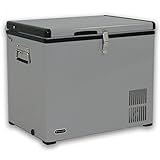
Let’s dive into the specifics and review each fridge individually. You can use the list below to jump and review specific models or you can read along and go through all the information.
1. Best Overall: Midea WHD-113FB1 RV Refrigerator
- Adjustable Temperature Ranges: Refrigerator Compartment 32' to 50' F /...
- Features Adjustable Legs and a Reversible Door that can Open from Left...
- Interior Light. Fresh section : 2.2 cubic feet, freezer section: 0.9...
Considering its amazing price, it’s crystal clear that it’s hard to beat what you get with the Midea Compact Refrigerator. Finding a two-door freezer/refrigerator combo in a mini-fridge size is a difficult task.
This unit is great for those of you who spend 99% of your time camping with AC power where the lack of liquid petroleum gas or DC power supply is less of an issue.
This fridge also features a modern design (its doors are made of stainless steel), which makes it a great pick if you’re renovating some older RV model.
Here is some more info about this badass fridge.
Pros
- It features separate refrigerator and freezer compartments
- It offers adjustable temperature ranges (the internal fridge temperatures range from 32°F to 50°F, whereas the freezer temperatures range from -11.2 degrees Fahrenheit to 5 degrees Fahrenheit)
- It comes with reversible door hinges that allow you to optimize the opening direction to suit the space
- It’s affordable
Cons
- Single form – only works with AC power connection
- It has no defrost feature
Features
- The whisper-quiet technology makes the compressor noise practically undetectable
- Interior lights, glass shelving solutions, and two crispers/drawers
Product Information
- Dimensions: 18.5” x 19.37” x 32.95”
- Weight: 52.2 lbs
- Freezer capacity: 0.92 cubic feet
- Freezer compartment(s): Yes
- Voltage: 115V
- Installation type: Freestanding
- Energy Star certified
- 1-year full warranty (for more information, please visit the respective Amazon link)
2. Avanti RA7316PST RV Refrigerator
- Avanti 7.4 cuff 2 door refrigerator plat
If you’re looking for an affordable, full-size refrigerator with the cooling power of a standard compressor, this unit may be your winner.
We love the feeling of a full-height refrigerator in an RV, which makes everything look and feel more like home.
Those of you with advanced solar power generation and an inverter can run this RV unit while off-grid living.
Pros
- Impressive interior volume
- Reversible door hinges – left or right opening
- Leveling legs
- Adjustable and removable glass shelves and door bins
- Full-range temperature control
Cons
- It’s heavy
- The single-form method of operation requires consistent AC power
Features
- Ice-cube tray
- Automatic defrost system to help minimize buildup
Product information
- Dimensions: 55.75” x 21.75” x 23.5”
- Weight: 92 lbs
- Freezer capacity: 1 cubic foot
- Freezer compartment(s): yes
- Voltage: 120V
- Installation type: Freestanding
- Energy Star certified and ADA compliant
- Limited 5-year warranty (for more details, check the respective Amazon link)
3. Smad RV Refrigerator
- Avanti 7.4 cuff 2 door refrigerator plat
Multi-power versatility is what you’ll get if you decide to go with the Smad Three-Way Fridge.
The ability to run on liquid petroleum gas, AC, or DC power is a huge advantage for RVers who spend a lot of time away from utility power sources.
Due to its small size and the fact that it has no freezer, this Smad refrigerator probably makes the most sense for smaller camper vans or trucks at tailgates as opposed to full-time RVing.
Pros
- Three-way power supply – LP gas, 110V, or 12V
- Highly energy-efficient
- Minimal noise
- Removable shelves, an adjustable foot for uneven surfaces, and reversible door designs
- Easy-to-use mechanical control
Cons
- Small interior volume
- No freezer
- No regulator and a hose
- Vent installation required for safe use
Features
- Piezo igniter for easy pilot lighting
- Temperature control
Product Information
- Dimensions: 18.11” x 18.9” x 26.77”
- Weight: 48.4 lbs
- Capacity: 2.12 cubic feet
- Freezer: No
- Voltage: 12V
- 1-year warranty (for more information, please visit the respective Amazon link)
4. Best & Smallest Portable RV Fridge: Dometic CF-035AC110 RV Refrigerator
- Three stage battery monitor
- Temperature read out
- High impact weather-resistant polypropylene cabinet
The performance of one of the leading brands in RV refrigerator manufacturing, Dometic, is evident with this portable refrigerator/freezer.
This unit is ideal for storing in your truck or outside of your camper to grab it and go wherever your cooling needs take you.
It can run connected to AC or DC power and it’s suitable for operation with a solar power system.
Pros
- Lightweight
- Comes with an electronic thermostat
- High-quality compressors
- Two-way power supply options
Cons
- Only one compartment; you must choose between freezing or refrigerating the contents
- Limited interior organization potential
Features
- Solar panel compatible
- High-impact exterior; durable and weather-resistant
- LED indicators and a soft-touch control panel
Product Information
- Dimensions: 21.26” x 14.09” x 9.25”
- Weight: 19.8 lbs
- Capacity: 10.5 liters
- 12/24V DC or 110V AC
- Dometic’s 2-year protection plus warranty
5. Whynter FM-45G Portable Fridge
- Convertible Small Freezer/Refrigerator: This small AC 110V/ DC 12V...
- Flexible Food Storage: This convertible refrigerator or freezer,...
- Fast Freeze & Consistent Temperature: Our portable fridge features an...
This Whynter model is another great option for tailgaters, RVers, or boaters who want to be able to bring their refrigerator anywhere they go.
The Whynter FM-45G relies on a corded power supply, either AC or DC. You can use a standard household 110V outlet or an automotive battery which is a 12V power source.
Pros
- Maximum portability
- You can choose between the refrigerator or freezer modes
- Powerful compressor cooling system
- Wire baskets for organization included
Cons
- No LP gas power option
- No separate compartments; you must choose the freezer or the refrigerator mode
Features
- Thanks to the fast-freeze mode, this unit can cool rapidly to -6°F
- It can function even when tilted up to 30° off level
Product Information
- Dimensions: 23.5” x 16.5” x 20.5”
- Weight: 45 lbs
- Capacity: 1.41 cubic feet
- Freezer option: Yes
- Separate freezer door: No
- 110V AC or 12V DC
- 1-year limited warranty
RV Fridge Vs. Residential Refrigerator
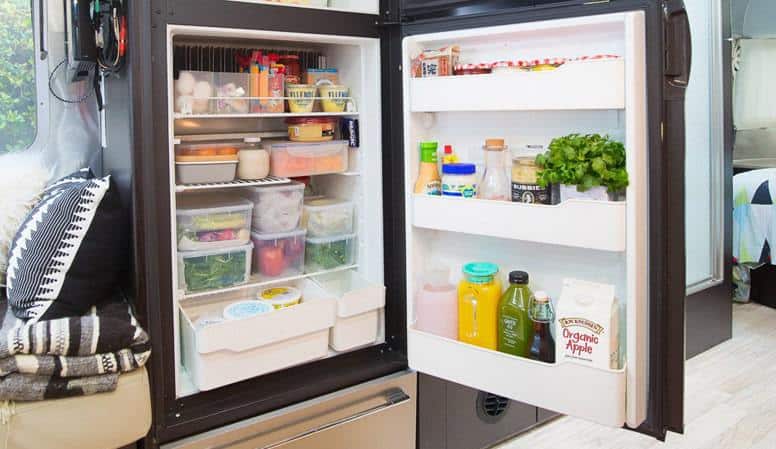
There are many factors that dictate the differences between most RV specific refrigerators and their residential counterparts.
RV refrigerators not only are smaller in size (they can fit with ease in the limited space inside an RV), but they also allow for alternative power sources.
Unlike the refrigerator in your kitchen at home, it’s common for those inside a camper to be without traditional shore power for long periods of time, whether during road trips or when camping off-grid.
Additionally, the components of residential refrigerators are usually unable to withstand the constant vibrations and bumping experienced on the road.
Portable units are designed with fewer moving parts and more durable materials. In order to satisfy the demands specific to the RV lifestyle, RV refrigerators use an entirely different method of cooling.
Make sure to look for an absorption refrigerator in a portable unit as opposed to a compressor version common in residential selections.
What Is An Absorption Refrigerator?
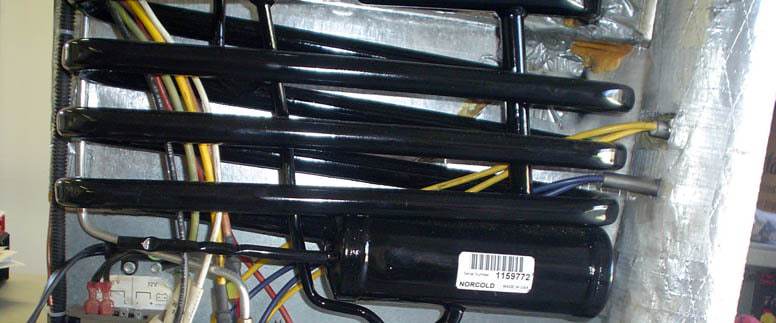
An absorption refrigerator is a unit that can cool itself via the burning of propane without any electricity. This is a significant advantage for use inside of an RV or in other situations where portability is important.
Envision a system of pipes within the rear of your refrigerator that contains anhydrous liquid ammonia. The heat generated from a small, pilot flame evaporates this ammonia through these tubes.
Upon mixing with water, the ammonia condenses and pulls heat from the interior space surrounding it. High-end refrigerators for RVs will often have 2-way power supply options.
When connected to traditional power, the heat is provided by an electric resistor. When disconnected from an alternating current power supply, however, it will operate via an LP propane tank.
It’s important to keep in mind that towing your travel trailer with your propane refrigerator running is not the safest option.
Ultimately, this is what keeps your food at the proper temperature after you disconnect the unit from the power box at one campsite and begin traveling towards another.
Types Of Refrigerators Used In RVs
The refrigerator types most commonly used in motorhomes, travel trailers, and conversion vans can be grouped into three main categories.
The space available in your RV, the number of food and drink items you plan to store at any given time, and the degree of portability you desire will help you determine which type is perfect for you.
Freestanding Refrigerators
These units are big enough to discourage you to move them frequently, yet small enough to fit in the narrow spaces often found in campers. This makes stand-alone refrigerators a great choice for many RV owners.
This style of refrigerators doesn’t require any special water hose connections or permanent installation mounts.
The fact that you can simply plug them in and place them wherever they fit within your RV space makes them popular for dorm rooms and apartments as well.
Dual Refrigerator/Freezer Units
If you’ve got the space, why not bring the comforts of your home kitchen into your RV?
A combination freezer/refrigerator gives you maximum food storage space without the need to decide whether you’d prefer to keep your food frozen or refrigerated.
With separate compartments maintained at proper temperatures, you’ve got the best of both worlds.
Portable Refrigerators
These refrigerators most closely resemble the ice chests you see people taking to the beach, park, and pool on hot summer days. They are small in size but give you the freedom to bring your cold drinks and snacks wherever your RV adventures take you.
Unlike the portable coolers for camping mentioned above, which require constant ice to keep the interior cold, portable refrigerators for RVs feature electric or battery-powered compressors that eliminate the need to fill valuable interior space with ice.
Given that these units are a popular first option for people on the go or in an RV, we’ve summarized some of the key benefits and disadvantages below.
Benefits
- Maximum portability and travel readiness
- High-end models can run cordless via an internal battery
- Fast cooling
- Durable exteriors made to handle harsh conditions, bumps, and scratches
Disadvantages
- One compartment; must choose refrigeration or freezing
- Limited space and organization
- Cost — the technology necessary to bring refrigeration on the go is expensive
- No option for LP gas power hookup
What Happens If You Use A Residential Refrigerator In Your RV?
The Four Horsemen of the Apocalypse arrive and destroy us all.
Okay, that might be a bit too dramatic, but there are, indeed, some key problems that you should be aware of if you choose to install a residential refrigerator in your RV.
Size
Residential refrigerators are bigger than the ones designed for portable or RV use. This may appeal to full-time travelers or those with big families, but they should bear in mind that finding cabinet space in an RV kitchen can be challenging.
If the camper was originally designed with an RV unit, your residential replacement may not fit into the designated cut-out space. Accommodating your RV’s kitchen to work with a residential fridge may require expensive carpentry and cabinet modifications.
Power Supply
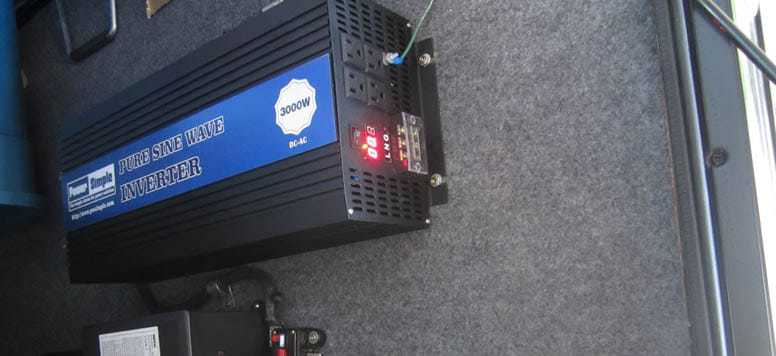
One of the biggest disadvantages of using a residential refrigerator on the road/in your RV is the fact that it’s only capable of running on 110V AC power.
This isn’t an issue when you are plugged in a campsite’s electrical box, but it will most certainly become one when you’re boondocking or trying to keep food and drink items cool while traveling.
In order to operate with the power supplied by your RV’s battery (a popular solution for power while on the road), you will need to purchase and install an inverter with your refrigerator that converts the 12-volt battery-supplied power into the 110-volt that your residential fridge needs.
You should also consider the greater power consumption of a residential refrigerator before installing one in your RV.
If you utilize a solar-powered system for your off-grid camping, there is a strong possibility that it won’t be able to handle the needs of a residential refrigerator, which is known to be a power hog amongst the electrical appliances.
Durability
Residential refrigerators are not designed to handle the constant vibrations, bumps, and unexpected jolts that take place when a camper is barreling down the highway at 65 mph.
Internal components, while lighter than those seen within refrigerators designed for RVs, are more prone to failure given the circumstances.
Popular Food/Drink Options For An RV Refrigerator
There is practically an infinite number of ways that you can take advantage of your fridge when traveling.
Here are just a few of the ways we find ourselves using our refrigerators when on the road:
- Fresh fruits and vegetables – This helps us eat healthy even while traveling, which can be a bit of a challenge.
- Cold drinks – It’s hard to beat the refreshment found in a cold drink after a day spent outside.
- Leftovers – One of our favorite things about visiting new places is enjoying the local cuisine. Once you buy a fridge for your RV, you’ll never say, “sorry, we can’t take the food with us because we’re camping” again.
- Breakfast foods – We like to try local restaurants for dinner, but having the chance to cook/prepare our own breakfasts helps us save money.
- Medicine or vitamin storage – Some medications, such as the popular Omega-3 fish oil pills, require refrigeration.
How To Install Your New RV Refrigerator?
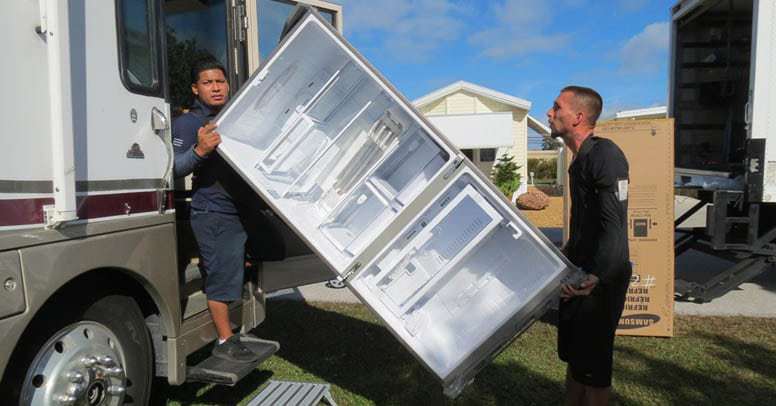
Before getting started with the necessary steps required to safely install your replacement RV unit, consider whether you are truly the best person for the job.
Removing an existing refrigerator and installing a new one is considered a moderately difficult process by most experienced RV technicians.
While those who are confident in their skillset will be able to handle removing/installing on their own (or at least with a friend convinced to help load and unload two refrigerators), several precautions will need to be taken.
You’ll be disconnecting the hardwired power supply and liquid petroleum (LP) gas lines that run to your current refrigerator.
There are serious consequences if this is not done correctly or if you forget to shut off certain valves before the disconnection.
If you don’t feel ready to tackle this project on your own, please take your RV to a reputable local RV repair shop that can manage the installation for you.
Sometimes, the peace of mind delivered by a professional install is well worth the additional investment it requires.
Preliminary Steps
- Determine whether your old RV refrigerator can fit through the doorway (some fridge installations were down before the RV wall panel and doors were built). If it can’t, you might have to remove a large window or windshield to be able to remove the old fridge.
- Make sure you’ve worked with your new RV refrigerator manufacturer to ensure that you’ve measured correctly and purchased the proper size for your cabinet cut-out.
Removing Your Old Refrigerator
- Fully close the liquid petroleum gas tank valve to stop the flow of gas through the lines. Access to this valve is usually found on the RV’s exterior via a small hatch or cover.
- Unplug your power supply cord and/or turn off your generator.
- Remove the vent/hatch panel located on the outside of your RV, providing access to the rear of your currently installed refrigerator.
- Unplug the refrigerator’s alternating current power cord.
- Disconnect the DC (12V battery-supplied power) wires from the refrigerator.
- Identify the gas line connection hose and disconnect it from the unit by screwing the bolt counterclockwise. Hearing a small release of the pressurized gas that remained in the line after shutting off the valve is normal.
- Determine if there are any screws (accessed from this panel) securing the fridge to its base or frame. If so, unscrew them now.
- Return to the interior of your RV and remove the remaining screws that secure the refrigerator to its frame. Depending on the previous method of installation, this may involve removing vanity plates and doors to access screw heads.
- You are now ready to remove the old refrigerator. It may be smart to protect your RV flooring before you attempt to slide it out. It can also be helpful to place a friend on the exterior of the RV to prevent any cords or gas lines from snagging as you pull it out of position.
Installing Your New RV Refrigerator
- Carefully insert it into the designated cabinet space, making sure not to scratch or dent the front panels.
- Return to the exterior of the RV and confirm that the gas line connection port lines up with your RV’s gas line hose. Have a professional install any necessary extensions or gas line piping modifications.
- Connect your RV’s gas line to the new refrigerator. Inspect for possible leaks by turning on the gas supply and then listening, smelling, and applying sudsy water to connection points. If no leaks are detected, turn the gas back off before continuing with electrical connections.
- Insert the DC wires into their respective housing and secure them in place. A voltmeter can help confirm which wire is positive.
- Plug the new refrigerator’s alternating current power cord into the outlet positioned for this purpose.
- Secure the fridge to its base and frame via numerous screws, typically supplied with the fridge. You’ll likely need to access screws from both the interior and exterior.
- You may need to route a condensation tube through the vent panel so that any moisture drips stay on the outside of the RV.
- Turn on your fridge and get ready to enjoy your updated kitchen. Don’t forget to let the interior cool completely before putting food in the fridge.
Keeping Your RV Refrigerator Clean
Regular cleaning of your fridge’s exterior and interior is a great way to extend its life.
It also helps to limit the amount of food waste and contamination that can develop from dirty conditions or spills that spread liquids onto other items.
Take a look at our recommended steps to keep your RV fridge in pristine shape.
Weekly (or with each trip in your RV)
- Be aware of foods that have been in the fridge for long periods of time and make plans to either eat them soon or dispose of them (if they’ve gone bad).
- Wipe the door handle of your refrigerator with a disinfecting wipe. This is a common place for bacteria in the kitchen since it’s often touched during and immediately after handling food.
Once every 3-6 months
- Remove all food items from your refrigerator, preferably when contents are low. This is a great time to throw out spoiled items and identify what needs to be eaten soon.
- Remove shelves and drawers to clean with warm, soapy water in a sink or wipe them down in place with a mix of water and vinegar.
- Make sure all cleaned surfaces are completely dry before putting food on them.
- Remove dust and/or food residue from the exterior by fully wiping all sides (don’t forget the top which often has lots of dust) with a damp cloth.
Once every 6-12 months
- Unplug your refrigerator from its power source and inspect the compressor and coils located on the back of the unit.
- Remove heavy buildup with a coarse brush and wipe down any visible dust with a clean, damp rag.
- Important: Never use cleaning chemicals on your refrigerator’s coils and always ensure that all power sources to the refrigerator are turned off before cleaning.
Key Considerations When Buying An RV Fridge
When searching for an RV refrigerator, answering the following questions can help you narrow down your options and ultimately find the most suitable product for your wants and needs.
How Much Space Do You Have Available?
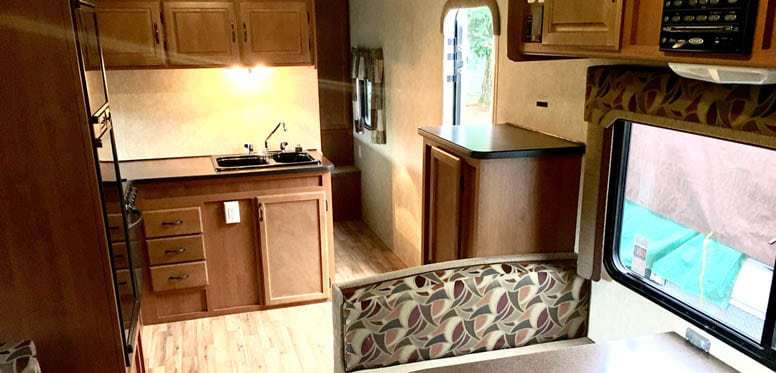
This is the number one determining factor for what type of RV fridge will work best for you.
Are you looking to add a refrigerator to your small camper van or do you want to replace one in a motorhome that already has cabinet space cut out for it?
Remember to factor in your RV slide-outs when deciding where to place your refrigerator.
We also recommend placing your refrigerator in a position where you won’t need to move it for every trip or each time you retract the slide-outs.
How Long Is Your Average Trip?
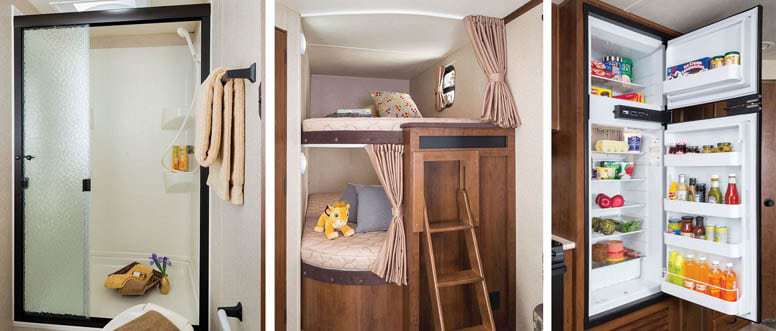
If you frequently set out for weeks at a time in your RV or are considering converting to full-time RV living (where consistent eating out is financially unrealistic), make sure you look for a dual freezer/refrigerator large enough to handle your daily dietary needs.
Try to avoid the situation where you end up needing to supplement your main refrigerator with multiple portable units.
This strategy not only takes up unnecessary space within your RV, but it also makes grocery organization a challenge (searching through 3 refrigerators or coolers for ketchup isn’t fun).
On the other hand, if you rarely camp for more than 2 nights on a weekend, then you may benefit more from a smaller, stand-alone refrigerator or a portable unit that gives you a few options for foods and drinks without occupying much space.
Where Do You Camp The Most?
Considering your favorite camping locations and their accompanying power supply options will help clarify which RV refrigerator will work best for you.
For example, if you rarely camp without access to an electrical box and AC shore power, then you might be able to get away with a larger fridge that uses more power.
Additionally, you wouldn’t need to be as concerned with the 2-way and 3-way operation modes of many high-end RV fridges (since you’ll rarely need liquid petroleum gas or direct current power).
Alternatively, if you often find yourself camping off-grid or at sites that don’t offer electrical hookups, then you might do better with a smaller, more energy-efficient fridge.
You’ll also need to think more about the power supply and whether your power generation methods (solar, battery, etc) are capable of handling a refrigerator running 24 hours a day.
A 3-way fridge will likely be a lot more versatile in this situation.
How Do You Plan to Power Your New Fridge?
Knowing how you’ll power your new refrigerator is one of the most important steps you need to take before placing a purchase order.
Residential refrigerators are more efficient at cooling, but they require power loads that aren’t suitable for most camping situations where you may not have shore power.
Instead, look for 2-way or 3-way models that run on liquid petroleum gas or direct current power while you are traveling or when you are without access to alternating current power.
These models will cost more and require a bit longer to cool, but they are specifically designed for mobile use and give you maximum flexibility for the many environments in which you camp.
How Many People Are You Feeding When You Camp?
RVers who travel with their family members and friends will, naturally, benefit from a larger refrigerator to accommodate their increased grocery needs.
If you travel solo, a smaller stand-alone fridge may save you both money (less propane) and space.
Do You Like to Cook While Camping?
Some folks believe that cooking a gourmet meal for their family members and friends during an RV trip is a big part of the fun.
Others are just as happy eating out or enjoying simple and traditional camping meals.
Knowing which of the two you are will help you determine what size capacity cooler will keep you, and your hungry guests, happy.
Final Thoughts
Ultimately, you’ll discover that an RV fridge can help you feel like you’re at home, regardless of which model you decide is best for you.
Life on the road can be expensive, which is why having the ability to store fresh food can save you thousands of dollars over the course of many trips.
With the combination of increased comfort and cost savings, incorporating a top-rated RV fridge into your travel lifestyle may be just what you need to keep the adventure going.



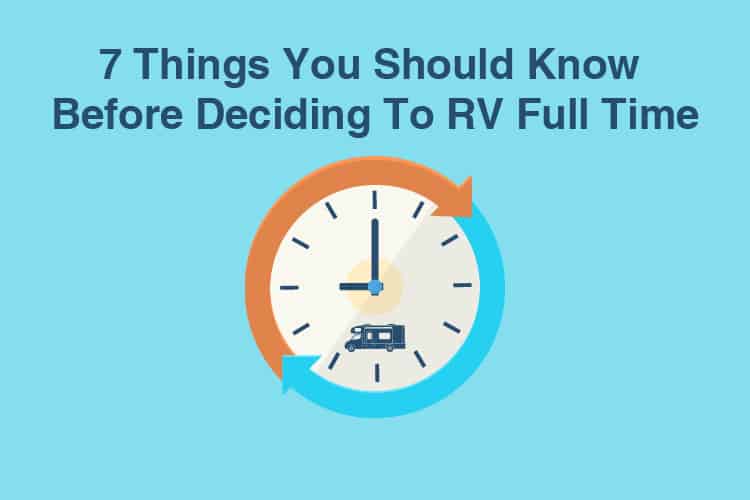

I want to how I can use my frigerator with just power supply not gas and how would I connect it
I’ve owned a Dometic for more than 10 years and an Alpicool C20 for 7. The Dometic got broken really often and I had to get it repaired a lot, so I had to replace it due to its power consumption, while the Alpicool has been really low on power and just comfortable to use. Even after 7 years it shows no signs of wear and tear.
I agree with you that Avanti RA7316PST is a good refrigerator but it has a problem that it freezes vegetables and made them become unfresh. However, it is still a product that RVers should buy.
I really like your content, it very clear about the pros and cons of each product that helps me easier to compare between product and product. I am gonna follow the other posts.
I am using Whynter FM-65G 65-Quart Portable Refrigerator. I’ve had my unit for about a month at this point. It has been used for camping and daily for work. It has kept everything cold and runs super quiet! I’ve read some pretty bad reviews, but I have had nothing but good things to say about the one I received! I have used it to keep drink and lunches cold daily at work and for 2 weekend camping trips in my RV. It’s runs so quietly that it’s hard to even hear it running inside of the RV.